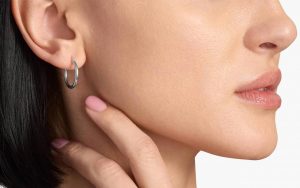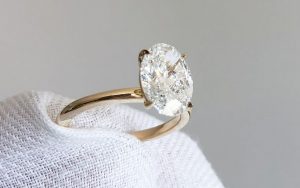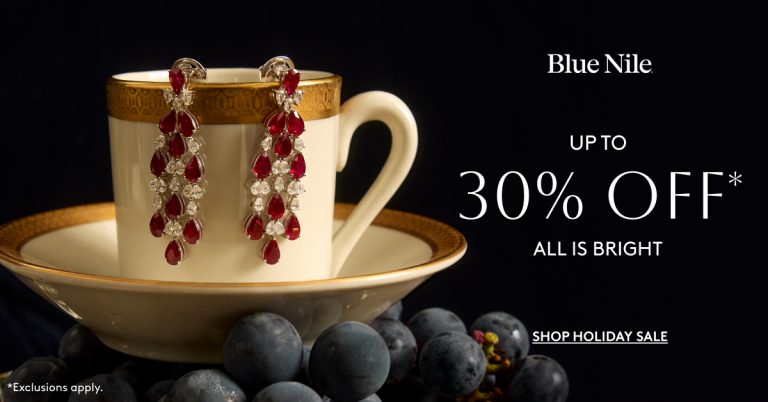Cubic Zirconia vs. Diamonds: How to Tell Them Apart
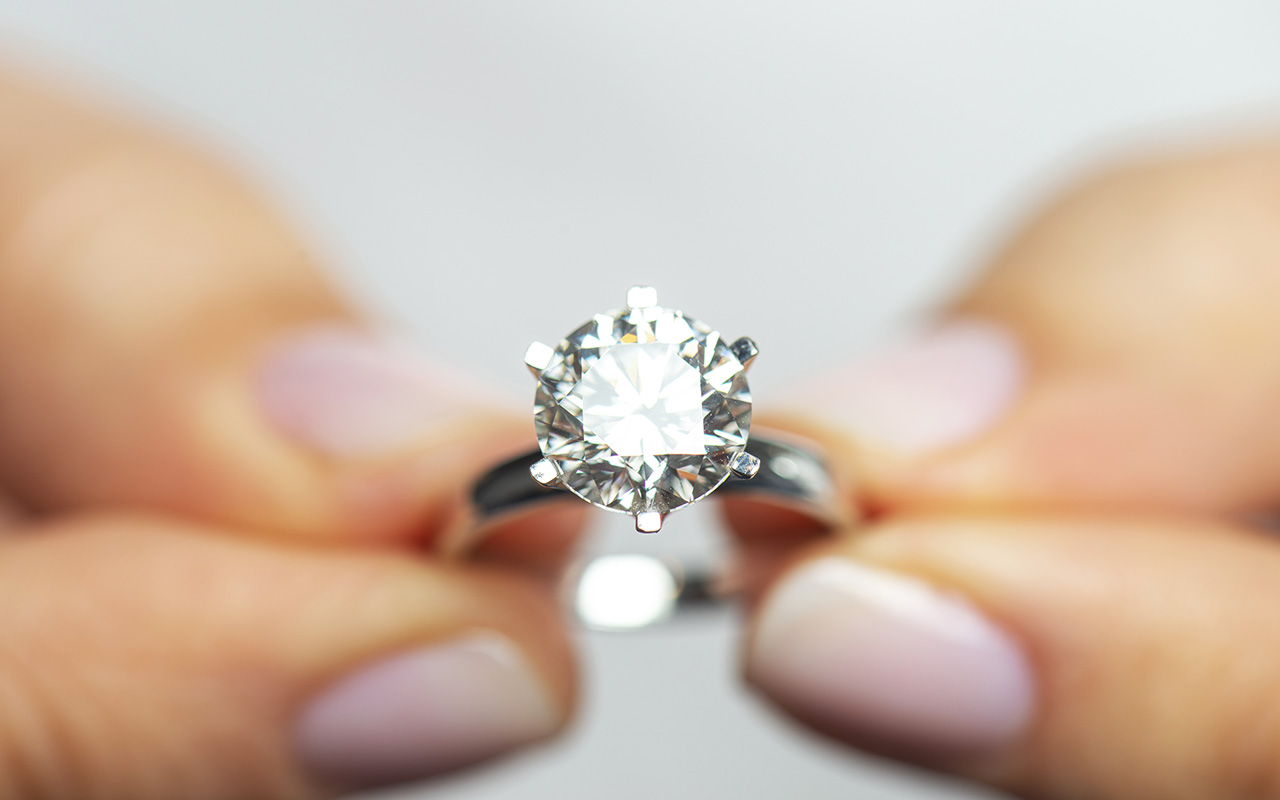
Cubic zirconia is a synthetic, glass-like gemstone, while diamonds are natural, durable, and brilliant. Key differences include composition, hardness, price and value, which influence longevity and resale potential. |
Diamonds have long been the standard for fine jewelry, with a price tag to match their status and quality. Budget-conscious shoppers seeking more affordable lab-made or natural diamond alternatives can compare cubic zirconia vs. diamonds, but will immediately recognize key differences.
Cubic zirconia is a simulated gemstone that mimics the look of a diamond at a fraction of the cost. Diamonds stand out for their superior quality, renowned brilliance and enduring durability. To select the right gemstone, it’s important to understand how zirconia differs from authentic diamonds.
Let’s explore the key differences between these two to help you choose the right stone for your style and budget.
Key Differences Between Diamonds and Cubic Zirconia
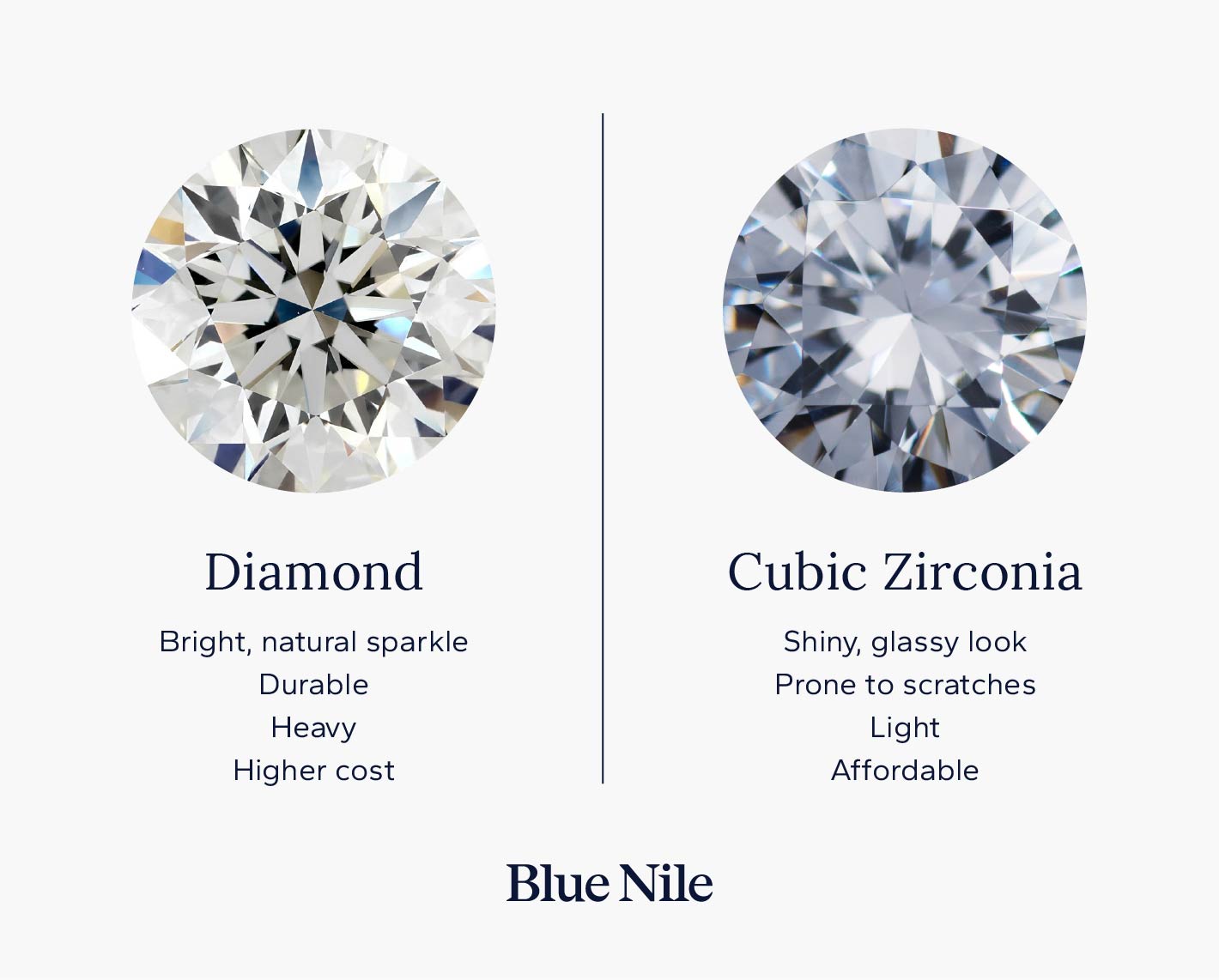
Diamonds and cubic zirconia (also referred to as CZ) are two popular options for jewelry, but they differ significantly in composition, appearance and value. Diamonds are natural gemstones formed deep within the earth, known for their exceptional hardness and brilliance. Cubic zirconia, on the other hand, is a synthetic gemstone made from zirconium dioxide, designed to mimic the look of diamonds at a lower cost.
While both can look stunning, understanding their main differences helps buyers make informed choices. Below, we compare their key attributes to guide your decision-making.
Difference
Diamond
Cubic Zirconia
Overall Appearance
Bright, natural sparkle; colorless to slight hues
Very shiny, often with a more glassy look
Brilliance
Exceptional, natural brilliance and high refraction
Good, but less complex light reflection
Hardness (based on the Mohs scale of hardness)
10 (hardest)
8–8.5 (softer)
Durability
Very durable, resists scratches
More prone to scratches and damage
Weight
Heavier for the same size due to density
Lighter, may appear larger
Average cost
Higher, varies based on quality and size
Less than 1% of a natural diamond’s price
Wearability
Lasts a lifetime, suitable for daily wear, heirlooms, investment pieces
Best for fashion, costume or temporary use
Appearance
When comparing a cubic zirconia vs. a diamond gemstone, the first noticeable difference is their appearance. Cubic zirconia stones tend to have a slightly glassy or rainbow-like sparkle. They can sometimes appear more flawless and perfect, especially to the untrained eye, which makes them popular in costume jewelry.
In natural sunlight, however, CZ looks less vibrant, often giving off a slightly cloudy or duller glow compared to a diamond’s brilliance. Diamonds, on the other hand, have a distinctive brilliance characterized by sharp, intense light reflection and a more subdued, elegant fire that enhances their depth and clarity.
If you’re searching for a gemstone that looks natural, subtle and refined, a diamond is the better choice. If you prefer a bright, eye-catching look at a lower price point, cubic zirconia can deliver that initial impact. Just keep in mind that CZ’s shine may diminish over time, unlike the enduring luminosity of a diamond.
Durability
Durability is a key factor that differentiates these two gemstones. Diamonds are renowned for their exceptional hardness, ranking 10 out of 10 on the Mohs scale of hardness. This hardness makes them highly resistant to scratches. They tend to hold their brilliance and integrity over a lifetime, making them ideal for everyday jewelry like engagement rings.
Cubic zirconia’s hardness level is around 8-8.5 on the Mohs scale, which makes it significantly softer. It can scratch more easily and is prone to developing chips over time, especially with frequent use or rough handling. CZ also tends to develop a duller appearance as it accumulates scratches, which can diminish its sparkle.
For longevity and maintaining a pristine look, a diamond will outperform a CZ. However, for occasionally worn jewelry or fashion purposes, the softer nature of cubic zirconia might be acceptable. Just be prepared for eventual surface wear and tear if you choose CZ.

Value
Value is perhaps the most significant distinction between these two. Diamonds are finite, natural gemstones with a well-established market. They are highly collectible and often passed down through generations. Their rarity and natural origin mean they tend to retain value over time.
Cubic zirconia, being a synthetic, manufactured stone, has a moderately low value and is considered a costume or fashion gemstone. You cannot resell it as a luxury item, nor does it carry any meaningful long-term investment potential. CZ’s affordability makes it appealing for trend-driven or travel jewelry, but it lacks the prestige and heirloom potential of a natural or lab-grown diamond.
- Price Point: Cubic zirconia’s price is significantly lower upfront, making it appealing for budget-conscious buyers.
- Investment: High-quality, certified diamonds may appreciate in monetary value over time, while also retaining sentimental value as heirlooms that can be cherished and passed down.
If your goal is a piece that can be treasured and possibly passed down, a diamond is the clear choice. However, if you seek an affordable, stylish piece for temporary wear or fashion, CZ is an inexpensive alternative.
Wearability
Diamonds are the preferred gemstone for engagement rings, wedding bands, investment pieces and high-end jewelry due to their durability and classic appeal. They’re suitable for daily wear and require minimal maintenance. They can withstand the rigors of life without losing their brilliance or getting damaged.
Cubic zirconia, on the other hand, is primarily used in fashion jewelry, costume jewelry and accessories designed for short-term wear or occasional use. Its lower durability means it can scratch, chip or become cloudy with frequent handling, making it less practical for everyday jewelry.
If you want a piece that endures daily wear and retains its brilliance, diamonds are the better option. For fun, trendy pieces or travel jewelry that can be replaced easily, cubic zirconia provides a cost-effective alternative.
How to Tell Diamonds and Cubic Zirconia Apart
Several telltale signs, including shine, facet sharpness, color hue, and weight, can help you tell diamonds apart from cubic zirconia. Home tests, like the fogging method or observing how the stone wears over time, can also help you distinguish between the two gemstones.
Whether you’re shopping online or inspecting jewelry in person, understanding these signs and tests can save you from overpaying for a gemstone that isn’t a genuine diamond.
Visual Clues to Differentiate Diamonds and Cubic Zirconia
Here are some key signs to tell diamonds apart from cubic zirconia:
- Shine: Diamonds reflect light with a sharp, bright brilliance, creating a lively sparkle. CZ, on the other hand, tends to have a more rainbow-like, less precise fire, often appearing more glassy.
- Facets and Edges: The facets on a diamond are usually crisp and precise, with well-defined edges. CZ may have slightly rounded or less refined facets, and edges might appear more blunt or less sharp.
- Color: Diamonds, especially higher grades, appear more natural and icy in sunlight. CZ often exhibits a slight bluish or rainbow hue under certain lighting conditions.
- Weight: A diamond is denser than cubic zirconia, meaning authentic jewelry feels heavier for the same size. If you have a piece of jewelry in hand, a lighter weight could indicate it’s a CZ.
Quick Tests to Differentiate Diamonds and Cubic Zirconia
Simple home diamond tests can help identify cubic zirconia vs. diamonds. Here are some tests you can perform to distinguish between the two stones:
The Fog Test:
- Breathe on the stone to fog it up.
- Observe how quickly it clears.
- Diamond: Clears almost instantly due to high thermal conductivity.
- Cubic zirconia: Takes longer to clear because it has lower thermal conductivity.
Wear Over Time:
- Regularly wear the jewelry for a few weeks.
- Watch for signs of scratches or clouding.
- Diamond: Highly resistant to scratches; remains clear and brilliant.
- Cubic zirconia: More prone to scratching and may develop a cloudy appearance over time.
These simple tests can give you quick insights, but for definitive results, we recommend professional evaluation or specialized testing.
What to Consider When Shopping
Choosing between a natural diamond and a more budget-friendly gemstone, such as cubic zirconia, involves considering several key factors.
When shopping for diamonds, focus on key attributes such as cut, clarity, color and carat weight. A well-cut diamond maximizes light reflection, creating exceptional sparkle, while high clarity ensures minimal inclusions are visible.
Color grade impacts how icy the diamond appears, while carat weight determines the stone’s size. For buyers seeking lasting value, Blue Nile exclusively offers fine, certified diamonds that meet rigorous standards of craft and brilliance.
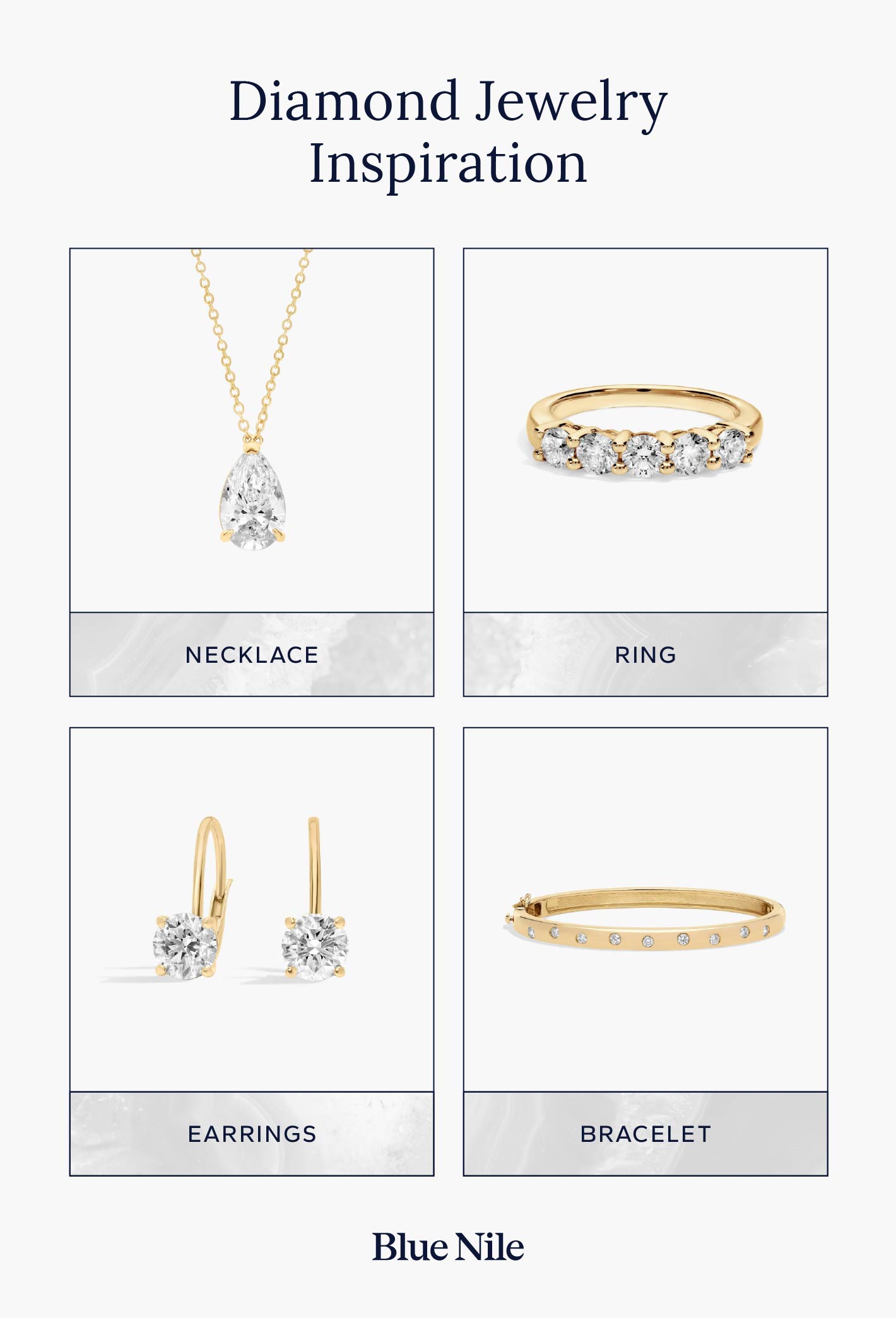
When shopping for cubic zirconia, it’s important to recognize that this gemstone is primarily manufactured for affordability. CZ is ideal for fashion, travel jewelry or statement pieces where cost and appearance matter more than longevity. The synthetic stone is less durable and more prone to scratching and clouding over time. These factors also mean that cubic zirconia doesn’t possess the intrinsic value of a real diamond.
Instead of cubic zirconia, you can opt for more valuable yet accessible diamond alternatives. Choose lab-grown diamonds or demi-fine jewelry crafted with high-quality simulants, such as white topaz or moissanite. If you’re worried about losing your precious pieces during outings or travel, consider jewelry insurance to cover loss or damage. It’s always better to choose timeless quality over affordable imitations.
What’s the Difference Between Lab-Grown Diamonds and Cubic Zirconia?
Lab-grown diamonds and cubic zirconia are two popular options in the world of jewelry, but they are fundamentally different in composition, durability and value.
Lab-grown diamonds are synthetic diamonds created through advanced technological processes that replicate natural diamond formation. They possess the same physical, chemical and optical properties as mined diamonds, making them genuine gemstones. In contrast, cubic zirconia is a synthetic, non-diamond gemstone designed to mimic the appearance of a diamond with a softer and less durable material.
Here’s a quick comparison to better understand the differences between cubic zirconia vs. lab diamonds:
Difference
Lab-Grown Diamond
Cubic Zirconia
Material Composition
Carbon crystals, the same as natural diamonds
Zirconium dioxide (synthetic glass)
Appearance
Brilliant, with a high refractive index and fire similar to natural diamonds
Very sparkly but with a different, somewhat “glassy” shine
Hardness (based on the Mohs Scale)
10 (hardest, same as natural diamonds)
8–8.5 (softer)
Durability
Very durable, suitable for everyday wear
Less durable, more prone to scratches and clouding over time
Average cost
Less than 20% of a natural diamond’s price
Less than 2% of a lab-grown diamond’s price
Value
Same potential as natural diamonds for resale and long-term value
Lacks intrinsic value and cannot be resold like a diamond
Note
Lab-created diamonds have the same optical, chemical and physical properties as natural diamonds. However, because lab-created diamonds can be produced in abundance, they are less expensive and make larger size diamonds more affordable. Their relative abundance may not ensure that they will hold value over time.
Choosing Between Diamonds and Cubic Zirconia
Ultimately, the decision between cubic zirconia vs. diamond stones depends on your preferences. Diamonds offer lasting value and timeless beauty for special moments, while cubic zirconia can be a budget-friendly option for fashion jewelry. If you’re prioritizing long-term value over affordability, you can find a premium selection of diamonds at Blue Nile. Explore our curated collection to find the perfect gemstone for your style.
Not sure which stone is right for you? See our diamond buying guide for more tips or contact our diamond experts for personalized assistance. Your dream gemstone is just a click away.
FAQs About Cubic Zirconia vs. Diamonds
Should I buy diamonds or cubic zirconia?
If you’re looking for lasting value and durability, diamonds are the superior choice. Cubic zirconia is a popular, affordable simulant for fashion jewelry but lacks the durability and brilliance of a real diamond. For meaningful, long-term pieces, it’s better to invest in genuine diamonds.
Is cubic zirconia real?
No, cubic zirconia is not a real diamond. It’s a synthetic, lab-created gemstone made from zirconium dioxide. It mimics the appearance of diamonds without the same physical or chemical properties.
What does CZ mean on jewelry?
CZ on jewelry stands for cubic zirconia, indicating the stone is a synthetic simulant. It’s often marked on fashion jewelry, such as earrings or costume pieces, to differentiate it from genuine diamonds or other precious gemstones.
Can you tell the difference between diamonds and cubic zirconia?
Yes, with the unaided eye and proper inspection, you can often tell the difference. Diamonds typically have more brilliance, fire and a hardness that makes them more resistant to scratches. CZ tends to look more glassy, softer and may show slight color or surface flaws over time.
